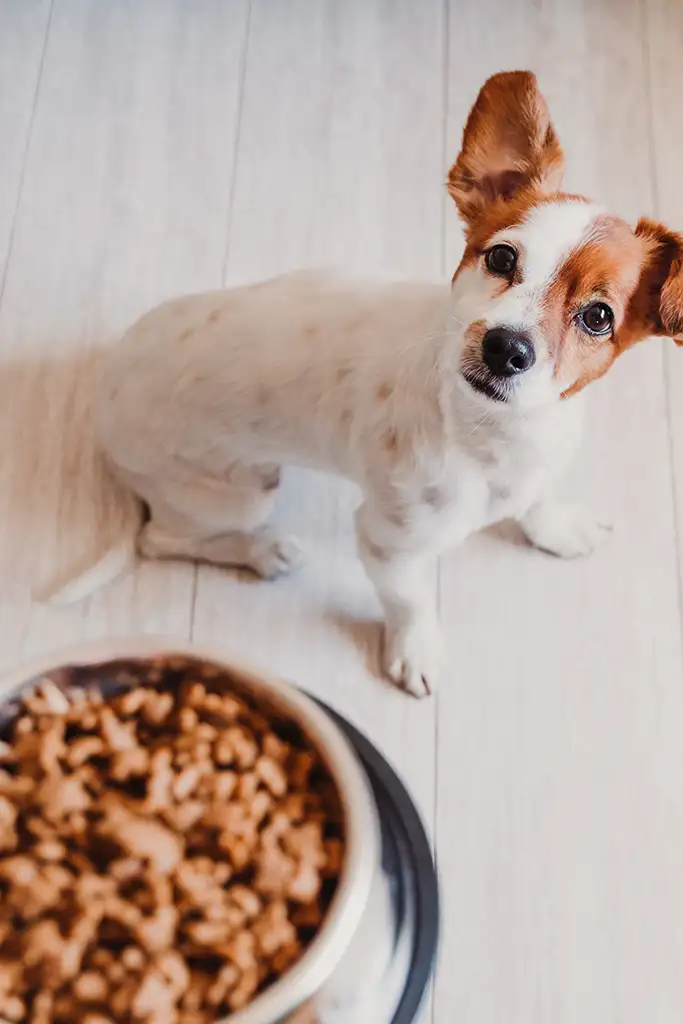7 Best Dog Harnesses for Akitas in 2024
Quick Guide
- What is the Best Dog Harness for Akitas?
- Different Types of Dog Harnesses for Akitas
- How Do I Ensure the Best Fit for my Akita?
- Overall Best Dog Harness for Akitas
- 6 More Highly Rated Dog Harnesses for Akitas
- Best Harness for an Akita Puppy
- Tips for Getting Your Akita Accustomed to Using a Harness
- Frequently Asked Questions
- Conclusion
Although typically gentle and serene, Akitas will move aggressively towards anything or anyone they perceive as a threat to their owners. When walking them in public, you’ll want them secured in a harness, which protects their neck and chest from damage should they pull against their leash.
Akitas have a unique body shape that you’ll need to consider when shopping for a harness. With an average height of around 26 inches, Akitas are sturdy, heavy-boned dogs with a large head. When selecting a harness, you’ll need one that is durable enough to handle the Akita’s strength but also flexible enough to fit without pinching their neck.
If you’re not sure which harness is best for your burly buddy, check out the complete guide below. We’ve rounded up our favorite Akita harnesses for 2024 plus all the info you need about sizing and harness training.
What is the Best Dog Harness for Akitas?
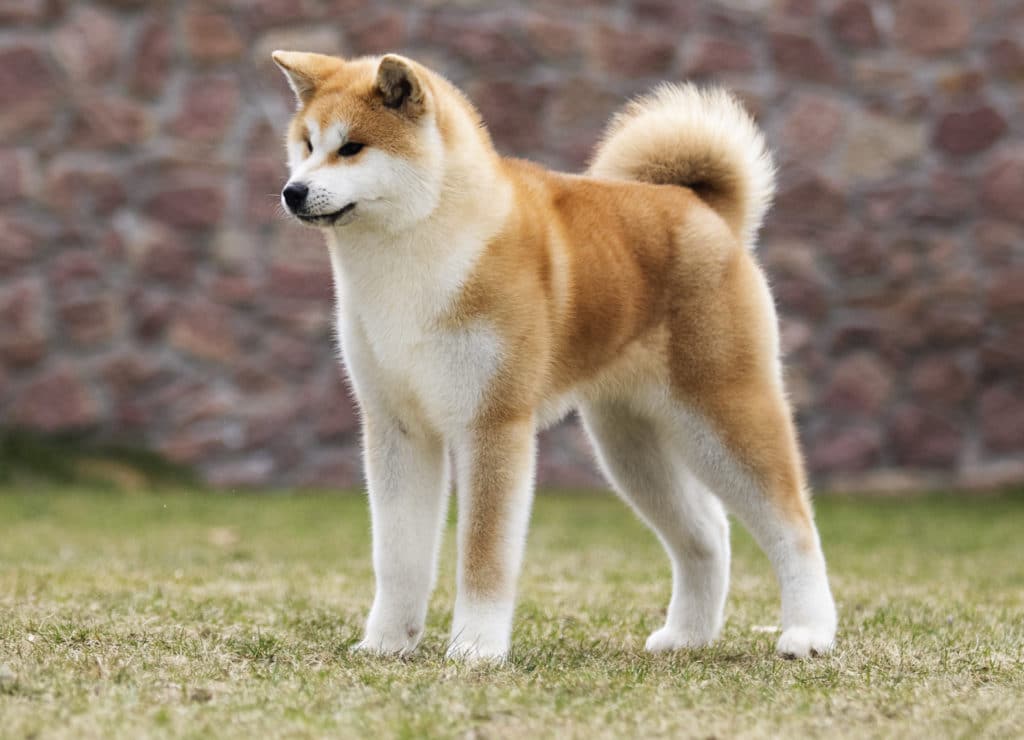
Different Types of Dog Harnesses for Akitas
First, you’ll need to choose between either an overhead or a step-in harness. If your dog is older or has mobility issues, a harness that slips over his head is often easier to use. However, some Akitas don’t like material touching their head, which makes a step-in harness the better choice.
You have two options for the clip location, which is the metal ring that attaches to the leash. It can be either on the front or back of the harness.
Generally, a back clip is the best option for most adult Akitas who understand proper leash behavior. When the leash attaches to the dog’s back, he can move freely, but you still maintain control over where he goes without putting pressure on his neck.
Front-clip harnesses have the ring attachment near the dog’s chest. These harnesses are mainly used as a training tool. When the dog pulls against the leash, his head is guided to the side instead of forward. Due to the increased risk of leg entanglement, front clip harnesses should only be used until the dog understands correct leash behavior.
You can also find leashes with both front and back clips. They’re useful because you can train a dog using the front clip, and then switch to the back after training is complete. However, this might not work with Akita puppies, who will likely outgrow several harnesses quickly as they mature.
Finally, some harnesses also act as a vehicle safety system. They clip into the seat belts in your car or truck. The American Kennel Club recommends keeping your dog in the back seat when traveling. Otherwise, the airbag can cause injuries in an accident, even if they’re securely belted.
How Do I Ensure the Best Fit for my Akita?
Because Akitas are large, burly and muscular, they can damage their neck when pulling on a leash attached to a collar. However, a harness allows the strain to distribute evenly and safely across the dog’s torso. Plus, a harness allows for greater control when walking your Akita.
First, use a cloth tape to measure the widest part of your dog’s chest. It’s usually the section underneath his front armpits at the pinnacle of the breastbone. Next, measure your dog’s neck at the thick point, which is usually slightly above the shoulders.
Finally, you’ll need your dog’s weight. If you have a puppy, you might get him to stand still on your home scale. Otherwise, your vet can help. Don’t rely solely on weight when sizing a harness. It’s used mainly as a broad classification.
Overall Best Dog Harness for Akitas
| Our 2024 Picks: Akita Harness Recommendations | |||
| Rank | Dog Harness | Price | Rating |
|
#1 |
 |
$$ |
A
|
|
#2 |
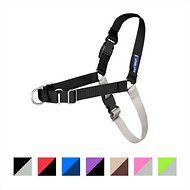 |
$ |
A+
|
|
#3 |
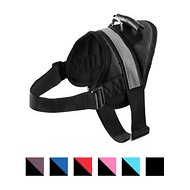 |
$ |
A+
|
|
#4 |
 |
$ |
A+
|
|
#5 |
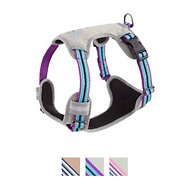 |
$ |
A+
|
|
#6 |
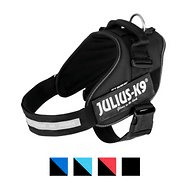 |
$$$ |
A
|
|
#7 |
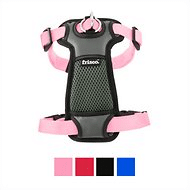 |
$ |
A
|
A dog as special (and strong) as an Akita needs an equally special harness. We found many excellent options, but one, in particular, stood out as the best.
Best Overall – Kurgo Tru-Fit Smart Harness
Our top recommendation for Akita owners is the Tru-Fit Smart Harness by Kurgo. It’s a winning combination of strength and ease-of-use.
Let’s start with durability. It uses an all-steel Nesting Buckle System similar to harnesses used by rock climbers and power company workers. You can rest easy knowing the clip won’t tear free from the harness, even if your Akita pulls with all his power.
It’s easy to fit properly, too. The harness has five adjustment points for a snug, precise fit. Additionally, you attach the harness by wrapping it around your dog’s body. Akitas have big heads, making overhead harnesses sometimes uncomfortable and awkward to put on.
Another feature we like is how the harness doubles as a vehicle safety system. Connect it to any standard seat belt system to help keep your dog steady and safe. It’s tested for up to 75 pounds.
6 More Highly Rated Dog Harnesses for Akitas
Although the Krugo is our top selection, it’s by no means the only option to consider. Here are six other options we love:
PetSafe Easy Walk Dog Harness
When a dog as large as an Akita pulls on his leash, he’s not just hard to control, his risk of throat and chest damage also increases. PetSafe’s Easy Walk harness gently but effectively prevents lunging and pulling, even when your Akita uses his full strength.
It’s a well-made harness with four adjustment points and a martindale loop on the chest to prevent leash twisting. Additionally, it’s easy to get on and off due to the quick-snap buckles and color-coded straps.
The harness also includes a Gentle Leader Headcollar. It’s a humane way to train even the strongest leash pullers. The Headcollar slips over the dog’s muzzle, so any lunging movement redirects their head to the side.
HDP Big Dog No-Pull Harness
Not just any harness will comfortably hold a dog as strong and muscular as an Akita. HDP’s Big Dog harness is up to the task with a wide, padded design that distributes weight away from his neck across his chest and shoulders.
The D-ring is located near the middle of the dog’s back, which allows your dog to move freely without sacrificing your control over his direction. Additionally, a built-in handle allows you to pull your dog close if you need to secure him in a tight space.
With 100% polyester construction with easy-click buckles, the harness fits snugly without chafing, irritation, or tightness. It’s an excellent option for keeping control of your buddy in busy public spaces and large crowds.
Halti Dog Harness
For a dog as powerful as an Akita, sometimes a regular harness doesn’t provide enough control. Halti’s dog harness combines a secure fit with unique anti-pull technology. It has two points of attachment. A ring on the dog’s chest allows for front attachment, while you can attach a second ring to the back to act as a brake.
It’s a great option for large dogs who pull on the leash but won’t wear a headcollar. The dual leash attachments allow plenty of control without applying painful pressure against your dog’s neck. It’s an effective option for leash training, especially with Akitas that are young in age but big in stature.
Blueberry Pet 3M Multi-Colored Dog Harness
Walk your dog in style with this fashionable, multi-colored harness from Blueberry Pet. It’s a lightweight, durable harness with four color options: violet and celeste, olive and blue-gray, emerald and orchid, and yellow and green. The vibrant color scheme is sure to have your dog looking his best.
More than fashion, it’s functional, too. The outer layer is a durable oxford that resists damage, while the inner mesh is comfortable and well-ventilated.
It’s eye-catching in another way. The outer layer has reflective stripes, and the top has a reflective triangle. High visibility from all directions is vital when walking your dog at night. Even though they’re large, they’re often hard to see in the dark without some type of reflective gear.
Julius-K9 IDC Powerharness Dog Harness
Julius-K9 is known as a leader in products made for working dogs, such as service dogs and rescue dogs. They’re harnesses are built for heavy-duty use, although without a ton of frills. However, if you have a big, strong, and active Akita, they’re a safe way to keep him under control around town and in all weather conditions.
The solid German materials make the harness freeze-proof and resistant to breakage. Also, the D-ring is solid steel. It’s built to last, so get one only after your dog is fully grown.
Although it’s durable, it’s also lightweight and flexible. An Eco-Tex inner liner gently hugs the dog while still allowing for plenty of natural airflow. The outer shell is water-repellent, and the buckles work even when frozen.
Best Harness for an Akita Puppy
Small but mighty, Akita puppies need the control of a harness when you take them in public. Fortunately, they usually have an easy time adapting to one even when they’re little. Here’s our favorite harness for Akita puppies:
Frisco Padded No Pull Dog Harness
Akita puppies are small, but they’re still strong. Fortunately, Frisco’s padded harnesses are up to the task. They’re made with durable yet flexible nylon webbing for a snug, comfortable fit. Additionally, a padded chest piece helps protect your Akita’s torso and neck if he pulls at the leash.
It’s also easy to adjust thanks to two fast-release buckles, a belly strap, and two shoulder straps. As your Akita grows, his harness can continue to fit him (at least for a while).
Finally, it’s both a front and back clip harness. Use the front clip to teach your puppy proper leash behavior, and then switch to the back clip for normal walking.
Tips for Getting Your Akita Accustomed to Using a Harness
Akitas are natural protectors, but sometimes this tendency can lead to trouble because they’ll take off towards a perceived threat to the family. A harness is a safe, humane way to keep them in control when out in public.
Intelligent and patient, most Akitas respond well to the harness. Check out the five simple tips below to help your Akita feel comfortable wearing the harness:
- 1. Start slow. Place the harness on the ground and let your dog explore. Pet him and give him lots of praise.
- 2. Place the harness on the dog. If he seems apprehensive, offer a treat to help keep him calm. Depending on the type of harness, you’ll either place it over his head or lift his front legs to step into it.
- 3. Don’t tighten the harness too much. You’re not looking for a perfect fit right now, and you don’t want to make your dog uncomfortable in a tight harness.
- 4. Let your dog wear the harness around the house. If he seems uncomfortable, praise him and pet him. Don’t remove the harness right away. Most dogs grow comfortable with a harness over time.
- 5. When your dog seems to ignore the presence of the harness, you’re ready to attach a leash and take him outside. Keep your first few walks reasonably short and away from distractions.
Frequently Asked Questions
What Type of Harness is Best for an Akita?
Akitas are large, imposing dogs that feel protective towards their owners. You need a harness that’s tough enough to handle a sudden lunge. It should also have plenty of padding around the chest to help protect against strain.
How Do I Find a Harness for an Akita Puppy?
You can size the harness in the same way you would an adult. The biggest mistake people make with an Akita puppy harness is using it for too long. Akitas grow fast; even an adjustable harness won’t keep up for long.
How Do I Know if a Harness Fits Correctly?
The major signs that a harness is too small include strap marks, chafing, and skin bulges when the harness is on. If it’s too loose, it’ll move around the dog’s body and allow for easy escape. When sized correctly, you’ll have enough room between the dog and the harness to fit two fingers.
What Features Should a Harness for an Akita Have?
Nylon is the most popular material used in harnesses because it’s tough, strong, and dries quickly. You also want rings and buckles made from either steel or heavy-duty plastic. Also, most owners prefer the extra safety of reflector strips or reflector seams.
Why is a Harness Better than a Collar?
If a dog pulls on a leash with a collar, all of the strain is focused directly on his neck. However, if he pulls while wearing a harness, the energy created is distributed evenly across his chest and back. It poses far less risk of many neck, chest, and head injuries.
Conclusion
Akita’s are truly one-of-a-kind canines, and you want to carefully select a harness to keep him safe and comfortable. Fortunately, all of the options listed above are highly-rated and trusted. The right harness allows you and your Akita to enjoy fun and adventures.











